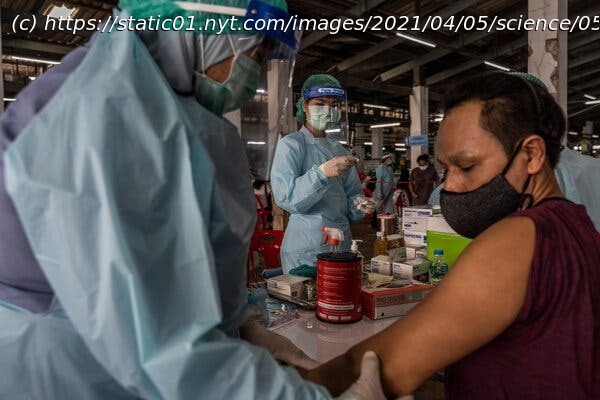A new formulation entering clinical trials in Brazil, Mexico, Thailand and Vietnam could change how the world fights the pandemic.
A new vaccine for Covid-19 that is entering clinical trials in Brazil, Mexico, Thailand and Vietnam could change how the world fights the pandemic. The vaccine, called NDV-HXP-S, is the first in clinical trials to use a new molecular design that is widely expected to create more potent antibodies than the current generation of vaccines. And the new vaccine could be far easier to make. Existing vaccines from companies like Pfizer and Johnson & Johnson must be produced in specialized factories using hard-to-acquire ingredients. In contrast, the new vaccine can be mass-produced in chicken eggs — the same eggs that produce billions of influenza vaccines every year in factories around the world. If NDV-HXP-S proves safe and effective, flu vaccine manufacturers could potentially produce well over a billion doses of it a year. Low- and middle-income countries currently struggling to obtain vaccines from wealthier countries may be able to make NDV-HXP-S for themselves or acquire it at low cost from neighbors. “That’s staggering — it would be a game-changer,” said Andrea Taylor, assistant director of the Duke Global Health Innovation Center. First, however, clinical trials must establish that NDV-HXP-S actually works in people. The first phase of clinical trials will conclude in July, and the final phase will take several months more. But experiments with vaccinated animals have raised hopes for the vaccine’s prospects. “It’s a home run for protection,” said Dr. Bruce Innis of the PATH Center for Vaccine Innovation and Access, which has coordinated the development of NDV-HXP-S. “I think it’s a world-class vaccine.” Vaccines work by acquainting the immune system with a virus well enough to prompt a defense against it. Some vaccines contain entire viruses that have been killed; others contain just a single protein from the virus. Still others contain genetic instructions that our cells can use to make the viral protein. Once exposed to a virus, or part of it, the immune system can learn to make antibodies that attack it. Immune cells can also learn to recognize infected cells and destroy them. In the case of the coronavirus, the best target for the immune system is the protein that covers its surface like a crown. The protein, known as spike, latches onto cells and then allows the virus to fuse to them. But simply injecting coronavirus spike proteins into people is not the best way to vaccinate them. That’s because spike proteins sometimes assume the wrong shape, and prompt the immune system to make the wrong antibodies. This insight emerged long before the Covid-19 pandemic. In 2015, another coronavirus appeared, causing a deadly form of pneumonia called MERS. Jason McLellan, a structural biologist then at the Geisel School of Medicine at Dartmouth, and his colleagues set out to make a vaccine against it. They wanted to use the spike protein as a target. But they had to reckon with the fact that the spike protein is a shape-shifter. As the protein prepares to fuse to a cell, it contorts from a tulip-like shape into something more akin to a javelin. Scientists call these two shapes the prefusion and postfusion forms of the spike. Antibodies against the prefusion shape work powerfully against the coronavirus, but postfusion antibodies don’t stop it. Dr. McLellan and his colleagues used standard techniques to make a MERS vaccine but ended up with a lot of postfusion spikes, useless for their purposes. Then they discovered a way to keep the protein locked in a tulip-like prefusion shape. All they had to do was change two of more than 1,000 building blocks in the protein into a compound called proline. The resulting spike — called 2P, for the two new proline molecules it contained — was far more likely to assume the desired tulip shape. The researchers injected the 2P spikes into mice and found that the animals could easily fight off infections of the MERS coronavirus. The team filed a patent for its modified spike, but the world took little notice of the invention.






